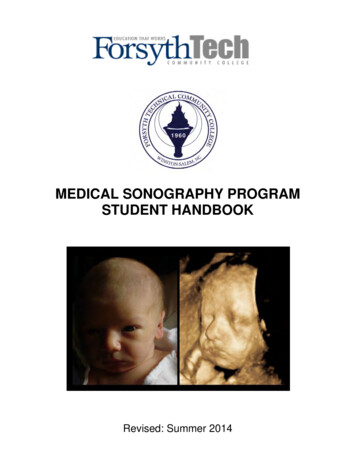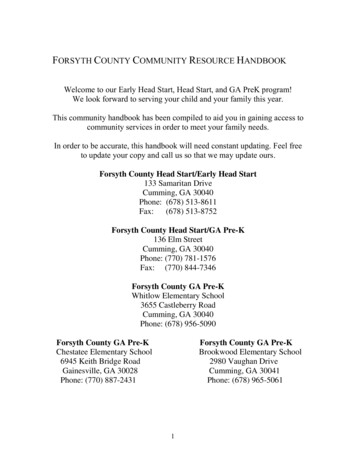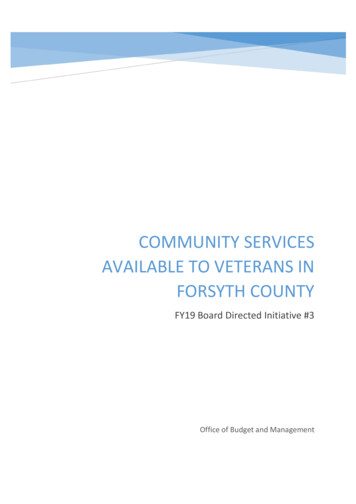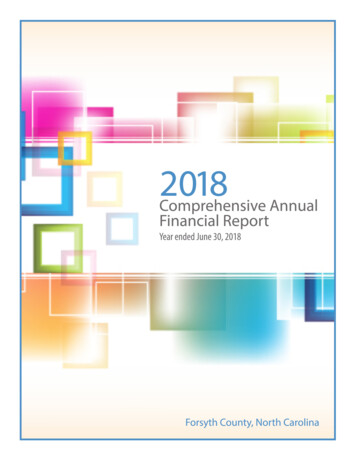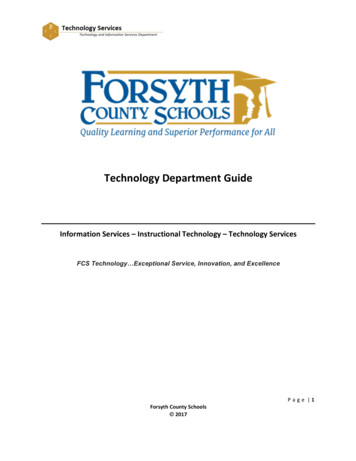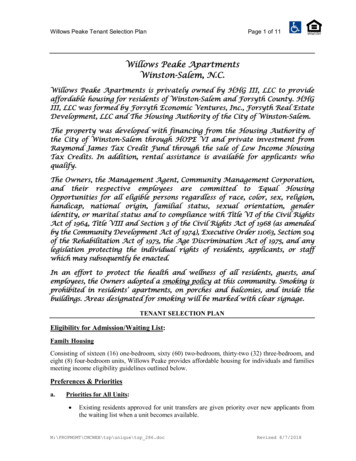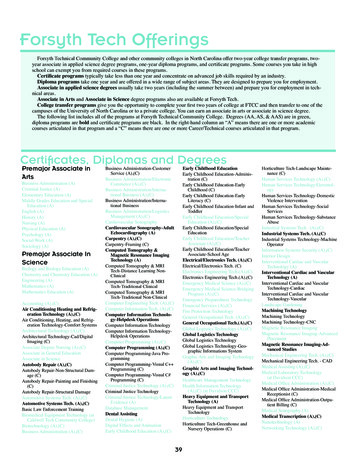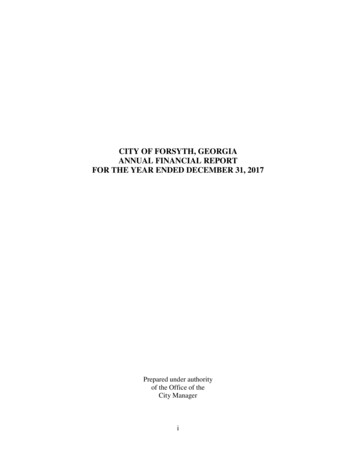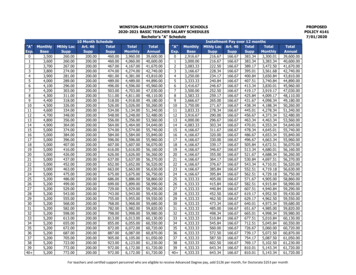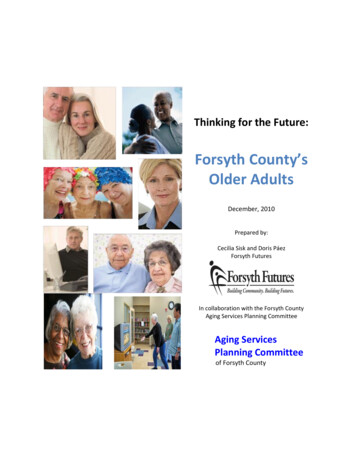
Transcription
Thinking for the Future:Forsyth County’sOlder AdultsDecember, 2010Prepared by:Cecilia Sisk and Doris PáezForsyth FuturesIn collaboration with the Forsyth CountyAging Services Planning CommitteeAging ServicesPlanning Committeeof Forsyth County
Table of ContentsExecutive Summary3Report Collaborators4About the Report6Who are our older adults?7Where do older adults reside?8What is the state of older adults’ health and wellness?11What transportation methods are used by our older adults?15What does our older adults’ financial picture look like?17How safe are our older adults?19How are older adults connecting in our community?22What issues should our community be thinking and talking about?27Tables and Figures29Appendix A: Data Sources and Definitions31Appendix B: Housing35Appendix C: Health45Appendix D: Transportation50Appendix E: Safety54Appendix F: Connecting with the Community60To view the Thinking for the Future: Focus on Forsyth County’s Older Adults report on-line, please go towww.forsythfutures.orgThe reader is also referred to the http://forsythaging.forsyth.cc/about.aspx for detailed informationregarding the committees and projects of the Aging Planning Services Committee of Forsyth County, aswell as community resources.2 Page
Executive SummaryThinking for the Future: The report, Forsyth County’s Older Adults, represents an effort to provideForsyth County’s residents, leaders and organizations with information to better address the needs ofolder adults (also referred to in the literature as senior citizens) with information. The goal of thisinformation is to assist the community in policy and program design, allocation of resources, funding orgrant applications, research, and/or program evaluations. The report is a small snapshot based onavailable public data of the status of Forsyth County’s older adults (65 unless otherwise stated) acrossdifferent areas of life. The snapshot is framed with general questions with quantitative responses aboutthese residents in terms of demographics, residence, health and wellness, transportation, financialstatus, and community connections. Based on the answers, issues that should be discussed and actedupon are presented for the community’s consideration.The answers suggest that our older adults currently represent a significant portion (13%) of ourresidents with steady growth projected. While the overwhelming majority (82%) of the residents in thiscategory reside within the city limits of Winston-Salem, they also represent important segments of theother county’s municipalities. Approximately half of our residents are in the 65 to 74 years of agecategory with one third in the in the 75-84 category. Most (61%) of our older adults are females. It issignificant to note that the life expectancy of women (from 84-88 years of age) in Forsyth County is onaverage consistently longer than for men (from 81-85 years of age). After reaching 85 years of age, thelife expectancy for women is up to 91 years of age and that for men is 90.Approximately 80% of the residents own their home. Past survey and community conversations suggestthat keeping older adults in their homes is clearly the goal for baby boomers and is the charge set by allentities who address the needs of older adults. Making our community a place that supports staying inthose homes is clearly a goal of the community. The data suggests that efforts in preventive health careand community connectivity (e.g., volunteerism, activity centers, and continuing education) are beingused by our older adults. They also represent a strong voting sector. However, the data suggests weneed to continue to strengthen our efforts to assist older adults with mobility issues and financialresources to assist with in-home health services, mortgages, and up-keep and home modifications. Weshould also be thinking about the safety of our older residents. While many of our older adults are stilldriving and are not involved in more accidents with respect to their younger cohorts, there are needs forassistance with transportation. Our community needs to be cognizant of the relationships betweenolder adults’ health, housing and safety needs. While we have many transportation strengths (e.g.Transaid, volunteer transportation services, and fee for transportation service subsidies), there are alsochallenges (e.g., expanding routes to outer areas of the county, variable criteria, rates, and/or schedulesfor transportation services). Our efforts to connect the unique and shared activity and services offeringsof the many governmental agencies, non-profits organizations and for-profit entities should continuallybe addressed.3 Page
Report CollaboratorsForsyth FuturesForsyth Futures is a non-profit organization that tracks indicators and supports collaborative initiativesaddressing Forsyth County’s progress in health, safety, education, environment, and citizenparticipation. The mission of Forsyth Futures is to continually improve positive outcomes for adults,children, and families of Forsyth County, North Carolina. Forsyth Futures’ work is guided by sevenprinciples: Improve equitable access. Address racial and other disparities. Nurture and value diversity. Treat everyone with respect. Maximize resources and minimize duplication. Encourage continuous improvement and innovation. Share ownership and accountability.Forsyth Futures applies systems theory as the conceptual framework to address the complexity ofcommunity change. Thus, the community is viewed as system being composed of interacting andinterrelating groups and activities. Forsyth Futures’ work is specifically designed to assist with (a) policyand program design, (b) resource allocation, (c) grant applications, (d) research, and/or (e) programevaluation.Forsyth County Aging Services Planning Committee (FCASPC)The Forsyth County Aging Services Planning Committee (FCASPC) [also referred to as the Aging PlanningServices Committee of Forsyth County] is a collaboration of aging service providers and older adults thatfocuses upon the needs and issues that concern older adults in our county. The goal of FCASPC is tomove toward a senior-friendly community; one that meets the needs of all older adults, whether frail orstill in the workforce, living in nursing homes or single family homes. FCASPC works to: Increase awareness of the issues we face as a community.Provide a forum for discussion of issues that face older adultsProvide educational opportunities with a variety of speakers and the open sharing ofinformationMake recommendations to the County Commissioners regarding Home and Community CareBlock Grant Funds.Members of the FCASPC committee are advocates for aging services that include: Older adults from throughout the countyService providersThe medical communityFoundationsRetirement and long-term care facilitiesCounty government4 Page
Contact InformationTo view the Thinking for the Future: Focus on Forsyth County’s Older Adults report on-line,please go to www.forsythfutures.org.The reader is also referred to the http://forsythaging.forsyth.cc/about.aspx for detailed informationregarding the committees and projects of the Aging Planning Services Committee of Forsyth County, aswell as community resources.Forsyth Futures601 N. Cherry StreetWinston-Salem, NC 27101Dr. Doris Páez, Executive Director(336) 724-2831Aging Services Planning Committee741 North Highland DriveWinston-Salem, NC 27101Diane Wimmer, Chairperson(336) 703-3870Vicki Poore, Administrative Assistant(336) 703-38835 Page
The Area Agency on AgingAboutthe ReportConversation ProcessIn 2007, Team 7 for the Forsyth County Senior Power Think Tank conducted a series of surveys directedtowards the baby boomer population in an effort to assess the broad issue of how they envisionretirement. In 2008-2009, a series of community conversations were convened in four towns(Kernersville, Lewisville, Rural Hall and Walkertown) and three locations in Winston Salem. The goal ofthese community conversations was to facilitate informal dialogue on processes and services that wereworking well and the challenges faced by aging adults throughout Forsyth County.In the spring of 2010, Forsyth Futures (FF) engaged the Forsyth County Aging Service PlanningCommittee (FCASPC) in conversations about indicators or metrics that were inclusive of older adults.During this same time frame, Governor Bev Purdue issued Executive Order 54, mandating the state toassess its readiness to address our aging population; including assessing current and proposed policies,programs and services for older adults. FCASPC has been doing this in a variety of ways since it wascreated by the Forsyth County commissioners in 1990.The conversation between FF and FCASPC evolved into a mutual interest in studying the “livability” orthe sum factors that add up to a better quality of life for older adults in Forsyth County. In an attemptto give more substance to that definition and to ensure that local interests were reflected, furtherconversations between the FCASPC and FF were held in the summer of 2010. Included in theconversations were reviews of national indicator reports (e.g., AARP and the Center for Home CarePolicy and Research1) and state aging population indicators.Data CollectionForsyth Futures’ data and research efforts are specifically designed to support community conversationsand actions in a timely manner and at a low cost. Twelve weeks (July-September, 2010) of research andanalysis time were dedicated to this project by the FF staff. Content review and editorial assistance wasprovided by the Executive Committee of the Aging Planning Services Committee.The information contained in this report is provided as a small snapshot of Forsyth County’s olderadults. This snapshot was framed by the following questions:1.2.3.4.5.6.7.8.Who are our older adults?Where do older adults reside?What is the state of older adult’s health and wellness?What transportation methods are used by our older adults?What does our older adult’s financial picture look like?How safe are our older adults?How are older adults connecting in our community?What issues should our community be thinking and talking about?The data gathering process involved review of federal, state and local, for-profit and non-profit entities’websites, available annual reports, and data sets provided by local entities. The results of the datareview and analyses are provided in this report.6 Page
A total of 47 indicators with a corresponding 96 measures were researched. Attempts were made toobtain the most current data available within the research time frame. Data sets from 2008-2010 wereconsidered. For each results area, key findings are presented in bullet points with its source(s). Sourcesfor all data are presented with each table or figure. A complete listing of tables, figures and references inthe report is presented at the conclusion of the paper. The report is designed in sections correspondingto the eight areas listed above. Complementary data and additional information not permitted in thebody of the paper are available in the appendices.Data ChallengesSeveral challenges were evidenced during the collection of data for this report.Challenge #1: Terms and DefinitionsOne major challenge is the differing terms (e.g. older adults, senior citizens, seniors, etc) used in thefield. A variety of definitions and age parameters are used for similar terms. Different institutions usedifferent age cut-offs for their data entry, analyses and reporting for older adults (e.g. age rangesstarting with 60 , 55 , 50 or 65 ). There is also a lack of consistency in the literature in the aggregationor disaggregation of age parameters from disabilities (e.g., physically disabilities) when considering“older adult” services in North Carolina and across its counties. Every county has their own criteria fordetermining who the beneficiary of services are based on their county’s features, budget constraintsand population needs. It was not possible to ascertain simply by looking at the data what criteria wasused. Additional time for individual interviews of county data producers would be required to capturethe various criteria for resource allocation. Key definitions are listed in appendix A.Challenge #2: Secondary DataThe information contained in this report was obtained primarily from secondary sources. As such, it isnot possible to verify the veracity of the data or analyses. Moreover, comparisons across data sets andreports from secondary sources can be difficult because a variety of data organization and reportingstrategies are used. Typically, the strategies and original data sets are not readily available or reportedby authors. This can lead to a disagreement among subject matter experts.Who are our older adults?Recent data compiled by the Northwest Piedmont Council of Governments (2009) and the Division ofAging and Adult Services (2010) shows that older adults (65 ) currently represent 13% of ForsythCounty’s total population (approximately 47,000 residents). It is projected that by 2025 they willrepresent 17% (approximately 71,000 residents). Adults (65 ) reside throughout the county with most(approximately 82%) residing in Winston-Salem. Other significant concentrations are in Kernersville (7%)and Clemmons (6%). Less than 2% live in each of the other 5 municipalities (Bethania, Tobaccoville,Walkertown, Lewisville, and Rural Hall). Most are in the 65-74 year old category (52%). The 75-84 yearolds, 85-94 year olds and 95 year olds, account for 33%, 13% and 2% of the older adult group,respectively. The majority of the population 65 are females (61%) and 39% are males. They areracially/ethnically diverse; 39% of the population 50 is Caucasian, 29% is Black and 7% is Hispanic.7 Page
Where do older adults reside?According to the Beyond 50.05 nationwide survey, more than 85% of the adults 65 earning less than 20,000 a year agree or strongly agree with the statement:”What I really would like to do is to stay in mycurrent residence as long as possible.” This percentage is just slightly lower (76%) for adults 65 whomake more than 50,000 a year 1.Some state, federal or local programs promote independence for older adults and persons withdisabilities. These programs will assist individuals who qualify by providing home improvements, repairsor modifications. A second reason to support helping senior citizens remain at home as long as possible isthe high cost of alternative housing options such as Assisted Living and Nursing Homes. For these tworeasons, it is important to assess whether Forsyth County is prepared to provide the necessary resourcesto help its senior citizens maintain their living independence and quality of life 2. Many live alone; 14.14% percent of males and 34.18% of females 65 live alone 3;Rural Hall has the highest population of 65 residents living alone (31%), followed by Lewisville(29%) and Winston-Salem (28%).According to several sources there are three answers to where our older adults reside.Answer 1: In their own home. 79.9% of persons 65 in Forsyth County owned their homes in 2009 4.Approximately 6,852 adults 65 lived in the rural areas of Forsyth County in 20095.The median home price in 2010 is 142,000 and the median monthly home cost for an owneroccupied home is 1,255 per month in Forsyth County 6.12.5% of adults age 65 reported that their homes are a cost burden in Forsyth County 7.16% of adults age 65 live in some type of independent living arrangement and 74% of them aresubsidized 8.Independent Living: Independent housing facilities that may be privately owned and may be subsidizedfor persons who qualify based on income. These housing facilities may or may not provide supportiveservices (e.g. elderly apartments).Residing in a home can be difficult as a result of financial issues. Consumer Credit Counseling Services(CCCS) of Forsyth County annual reports indicated that for FY 2010 (July 2009-June 2010) that9: 515 adults age 50 requested Foreclosure Prevention Counseling.267 adults age 50 requested Housing Counseling.1% of the adults 50-59 years old requested Foreclosure Prevention Counseling.Less than 1% of adults 60 requested Foreclosure Prevention Counseling.8 Page
Answer #2: In their own home with assistance.With increasing financial and health difficulties, there arises the need for strategies for staying in placewith subsidies and in-home health assistance. Homeowners 65 have different options to fund homemodifications that will enable them to live independently longer. Depending on their financialcircumstances, they could utilize various sources of funding such as reverse mortgages, federal, state orlocal funding or cost off-sets such as tax breaks 10.North Carolina has 14 federal, state and local programs to assist individuals age 60 to live safe andindependently. While many entities provide information or referrals for different grants, there is not asingle agency that provides information and is in charge of processing all the grants. Out of 100 countiesin North Carolina, 30 counties have an entity that is specifically in charge of informing residents abouthome improvement funding programs (See Appendix B for a list of grants and contact information).None of the five counties with the greatest populations (Wake, Mecklenburg, Guilford, Forsyth andDurham) in North Carolina have such an agency 11. In terms of home modifications, here is the 2010 yearto date information:In Forsyth County the 2010 data suggests: Home updates range from 7,500 to 75,00012.There are 24 contractors certified in aging in place modifications13.Reverse Mortgage’s clients borrowed 6,984 to 406,60714.Consumer Credit Counseling Services of Forsyth County provided 242 Reverse MortgageCounseling sessions for adults 62 plus15.Among the in-home assistance options, there are a variety of older adult supports (e.g. in home-aid)(See Appendix B for a list of in-home aid alternatives). These options assist older adults to stay in theirhomes longer and provide assistance with home management tasks (e.g., cooking, cleaning theirimmediate living area, laundry, shopping, and bill paying and reminding them to take their medications).Table 1 indicates the expenditure per client for five counties in North Carolina for this service (SeeAppendix B). In addition to in home care support, there are organized programs of services during theday in a community group setting for the purpose of supporting adults' personal independence andsupport family care takers (e.g. Adult Day Care/Day Health)16. The cost for In-Home Aide services may be between 11- 15 per/hour 17.There are 2 Adult Day Care/Day Health providers in Forsyth County18.9 Page
Table 1. Expenditures per Client 60 For Adult Care SupportAgencyNC Division ofAging andAdult ServicesNC Division ofSocial ServicesDurhamForsythGuilfordMecklenburgWake 2,382 2,391 5,486 3,247 5,260 2,402 3,080 3,157 2,604 3,595(19) Source: North Carolina Division of Aging and Adult Service, Website, 4, 2010Answer #3: Alternative living arrangements.When older adults cannot remain in their homes, several residential alternatives exist. The North CarolinaDivision of Aging and Adult Services define two additional types of living arrangements:Nursing Homes: Facilities that provide nursing or convalescent care for three or more persons perlicensee.Assisted Living Residences: Facilities designed for aged and disabled adults who may require 24-hoursupervision and assistance with personal care needs. Medical care may be provided on occasion but isnot routinely needed. In Forsyth County, about 4.9% of adults 65 live in nursing homes 20.There are about 3.39 women for every man residing in a nursing home.5% of adults age 65 live in assisted living arrangements in Forsyth County 21.Table 2. Alternative Living ArrangementsHousing TypeAssisted LivingNursing HomesProfile80% have a rating of 3 out 5stars, 17% have a rating of 4,and 3% have a rating of 2.All nursing homes areMedicaid and Medicarecertified. 42% of them havean overall rating of 4 out of 5,25% have a rating of 3, 17%have a rating of 2, and 16%have a rating of 1.Number4012(22) Source North Carolina Division of Aging and Adult Service, Website, 4, 2010*Note: There are other 4 nursing homes that are not Medicare or Medicaid certified in Forsyth County10 P a g e
What is the state of older adults’ health and wellness?As indicated in the previous response; some older adults have health issues that limit their independence.However, many older adults are strong and physically viable. In the National Center for Chronic DiseasePrevention and Health Promotion report (2009), 74% declare themselves as being in good health 1. Only 8%of adults 65 have a “self-care disability” (i.e., needing help with dressing or bathing) and 17% of adults 65 have a disability that requires institutionalization or external care)2. However, poor health is the biggestpredictor of older adults needing institutionalization. For this reason, preventative care and maintenanceare keys to continuing to live independently. There are six areas to consider when addressing this question:Answer #1: Life ExpectancyLife expectancy is a general indicator of health and is useful in projecting service needs. Figure 1 is adepiction of life expectancy by older adult age groups in Forsyth County. The life expectancy of women in Forsyth County is on average consistently longer than men by3.1 years. This gap reduces progressively to one year at the age of 85 3.The life expectancy of a female age 60-64 years old is 84-88 years old. The life expectancy of amale age 60-64 years old is 81-85 years old.The life expectancy of Caucasians is longer than African Americans in most age stages and onaverage. But, this gap also reduces progressively and, African American life expectancy evensurpasses the life expectancy of Caucasians by age 80.The life expectancy of a Caucasian age 60-64 years old is 83-87 years old. The life expectancy ofan African American age 60-64 years old is 80-84 years old.Figure 1. Forsyth County Life Expectancy302520Male15Female10Caucasian5African American060-6465-6970-7475-7980-8485 (3) Source: North Carolina Center for Health Statistics, Website, y/, updated in 200911 P a g e
Answer # 2: Healthy BehaviorsThe first step to remaining healthy is to maintain healthy habits. Table 3 provides information abouttwo indicators of a health promoting life style. In terms of nutrition and wellness, Forsyth County’s 65 population has a higher percentage of individuals with healthy habits when compared to the total 65 population in North Carolina.Table 3. Comparative Nutrition and WellnessIndicatorsWellnessObesityMeasuresForsyth County Adults65 North Carolina Adults65 ) Source: National Center for Chronic Disease Prevention and Health Promotion, Website, r #3: Preventative and Maintenance of Health ServicesThe second step to maintaining good health is to have periodic examinations to screen for potentialillness as well as receiving regular treatments to prevent diseases that may be deadly. F or instance,nationally, pneumonia shortens the life expectancy of a person by four years on average5. Table 4provides information about three indicators of disease prevention and control. In terms of receivingpreventative care, immunization rates and oral health, Forsyth County’s 65 percentage is slightly abovethe 65 percentage in North Carolina. This suggests a relatively strong local system for preventativecare.Table 4. Comparative Preventative Care and ImmunizationIndicatorsPreventative CareImmunizationOral HealthMeasuresAdult womenMammogramCholesterol CheckColonoscopy CheckPneumonia ShotFlu VaccineDentist VisitForsyth CountyAdults 65 86.8%North Carolina Adults65 (5) Source: National Center for Chronic Disease Prevention and Health Promotion, Website er # 4: Chronic Disease and DisabilitiesDaily functioning and physical functioning are keys to a healthy quality of life. For that reason, we listfive indicators that may impede older adults daily functioning. Table 5 provides information about theseindicators of chronic diseases and disabilities.12 P a g e
Table 5. Comparative Chronic Diseases and OthersIndicatorsMeasuresDisabilitiesAdults limited by physical,mental or emotional disabilitiesAdults with health issues thatneed special equipmentHip FracturesDentalDiabetesCardiovascular DiseasesHip FracturesComplete Tooth LossDiabetesHeart AttackStrokeCoronary Heart DiseaseForsyth CountyAdults 65 30.7%North CarolinaAdults 65 %21.3%13.5%8.6%11.8%(6) Source: National Center for Chronic Disease Prevention and Health Promotion, Website r # 5: Medicaid and Medicare utilizationKnowing the number of potential Medicaid and Medicare users for the next ten years is important inaccurately assessing the future budgetary and healthcare service demands on the county. The USCensus Bureau reports the following7: As of year 2010, 5,165 adults 65 are eligible for Medicaid.From 2010 to 2020 the increment per year of residents eligible for Medicare will increase 2-4%from the previous year.From 2010 to 2020 there will be an increase of 35% of residents eligible for Medicaid.Figure 2. Number of Medicare Eligible 62017201820192020(8) Source: US Census Bureau, /9525rank/ncprsrel.txt, use 2010-2020 projections13 P a g e
Figure 3. Number of 65 Persons Medicaid 0192020(9) Source: Us Census Bureau, /9525rank/ncprsrel.txt, use 2010-2020 projectionsAnswer # 6: Availability of Health ServicesThirty five percent of all patients were 70 in Forsyth Medical Center (* Note legal name is Forsyth Memorial Hospital)from June 2009 - May 201010 (*Note Request for Forsyth County, 65 data for Forsyth Medical Center was being processed at publication date).From July 2009 – June 2010, 44% of the patients in WFUBMC 11 and twenty percent of all patients at thethree Prime Care facilities were 65 12. Since older adults are a significant proportion of patients, it isimportant to assess if Forsyth County has an adequate supply of medical services to meet the needs ofan aging population. According to the North Carolina Department of Health and Human Services, thefollowing licenses were issued in Forsyth County: Forsyth County has 2 major licensed hospitals (WFUBMC and Forsyth Medical Center (*Note ForsythMemorial Hospital is the legal name). In addition, there are two other entities licensed as separate hospitals:Medical Park Hospital and Select Specialty Hospital-Winston Salem13.There are 30 geriatric specialistsRelated to the issue of health providers, we need to know the number of other health relatedservices in the area that support adequate care. A review of several business sources (e.g. yellowpages, internet searches, etc) yielded the following: Forsyth County has 99 pharmacies 14.In general, medical care and pharmacies are located within the zip code 27103 which includesArdmore, the Stratford Rd neighborhood, Hanes Mall neighborhood, Peace Havenneighborhood, South and Southwest neighborhood 15 (See Appendix C for a list of medical providers).14 P a g e
What transportation methods are used by our older adults?adults?There arefive transportation alternatives for older adults: motor vehicle, public transportation,Transaid, private transportation and volunteer transportation. It is important to know all the resourcesthe community offers to help older adults move around the county.Answer # 1: Motor VehiclePrivate transit is a major form of transportation for many older adults. It is the method oftransportation that provides older adults with the highest level of flexibility and independence. Table 6presents the percentage and number of older adults who are no longer driving. According to the NorthCarolina Division of Transportation (personal communication), Forsyth county’s older adult driver profileis as follows1: 10.23% of females do not drive between the ages of 65-74 years old. The rate at which femalesno longer drive increases with age.20.87% of women do not drive between the ages of 75-84 years old. 51.82% of femalesbetween the ages of 85 to 94 do not drive. And, 89.8% of women ages 95 do not drive.9.75% of men aged 65-74 years old do not drive. This percentage is comparable with women ofthe same age cohort.13.48% of men aged 85-94 years old do not drive. However, this is considerably lower than thepercentage of women in the same cohort (51.82%).Table 6. Percentage of Residents Who Do Not Drive in Forsyth County by Age GroupAges35-4445-5455-5960-6465-7475-8485-9495 %16.48%9.82%10.32%9.13%9.75%2.75%13.48%58.72%Males Population4,0732,3791,0798371,101169262101% 0%Population2,8501,6518467141,3521,9542,187546(2) Source: North Carolina Division of Transportation, Personal Communication, S. Abbott, June 2010(3) US Census Bureau, Website, /9525rank/ncprsrel.txt, used projections 2010Answer # 2: TransaidTransaid provides free general and medical transportation services for adults 60 who are Medicaidrecipients and adults with a disability, otherwise the servic
Winston-Salem, NC 27101 Dr. Doris Páez, Executive Director (336) 724-2831 Aging Services Planning Committee 741 North Highland Drive Winston-Salem, NC 27101 Diane Wimmer, Chairperson (336) 703-3870 Vicki Poore, Administrative Assistant (336) 703-3883

